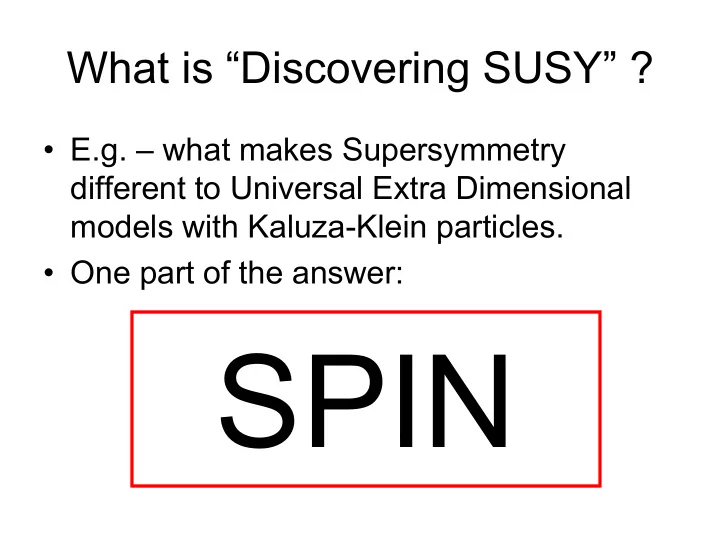

What is “Discovering SUSY” ? • E.g. – what makes Supersymmetry different to Universal Extra Dimensional models with Kaluza-Klein particles. • One part of the answer: SPIN
QUACK ! QUACK ! Not all things that quack are ducks!
We will see two important themes: • Mass measurements will precede ( * ) spin determinations • “Spin measurement” ( ** ) should not be confused with “sensitivity to spin” (*) or will at best be simultaneous with (**) Here “spin measurement” means “determining unambiguously the correct nature (scalar, fermion, vector) of one or more particles in a decay chain or model
(more info at) A REVIEW OF SPIN DETERMINATION AT THE LHC Lian-Tao Wang and Itay Yavin arXiv:0802:2726
Spin determination topics • Consistency checks • Spins in “QLL chain” – A.Barr hep-ph/0405052 – Smillie et al hep-ph/0605286 – Florida etc arXiv:0808.2472 – Biglietti et al ATL-PHYS-PUB-2007-004 • Slepton Spin (production) – A.Barr hep-ph/0511115 • MAOS method – Cho, Kong, Kim, Park arXiv:0810.4853 • Gluino chain spin – Alvez, Eboli, Plehn hep-ph/0605067 • Spins in chains with charginos – Wang and Yavin hep-ph/0605296 – Smillie hep-ph/0609296 • Spins in chains radiating photons – Ehrenfeld et al arXiv:0904.1293
Spin Consistency Check
Spin Consistency Check Consistent with: Relative Frequency Straight line • Phase-space • Scalar slepton (SFSF) • Fermion KK lepton (FVFV) Di-Lepton Invariant Mass (GeV)
QL Spin Determination (A.Barr) “NEAR” “FAR” 2 problems: How can we distinguish the „near‟ lepton from the „far‟ lepton? How can we tell from ?
Quark+NearLepton invariant mass distributions for: L+ L- L+ L- and and ANTI -QUARKS QUARKS Back to back Back to back Probability density Probability density _ in 2 0 frame in 2 0 frame QL + QL - Phase space Phase space _ (spin-0) (spin-0) QL - QL + sin ½ θ * sin ½ θ * hep-ph/0405052
Experimental problem • Cannot reliably distinguish QUARKs from ANTI-QUARKs In experiment, can only distinguish Can only distinguish lepton charge RED(QL+,_ L+) from BLUE(QL-,_L-) RED(QL+,QL+) from BLUE(QL-,QL-)
Expect QUARK and ANTI-QUARK contributions to cancel: QL + jL + _ SUM QL + _ QL - jL - SUM QL -
hep-ph/0405052 But LHC is Proton-Proton machine • More Quarks than Anti-Quarks! So get: QL + jL + _ SUM QL + Asymmetry! _ QL - jL - SUM QL -
“Far” Lepton washout? “NEAR” “FAR”
So define m jL+ , m jL- asymmetry jL + where parton-level Asymmetry “A” jL - spin-0 detector-level M jL / GeV sin ½ θ *
Different method altogether
Direct slepton spin detection: qq →Zγ* →slepton slepton l ~ ~ 0 l 1 R ~ ~ 0 l R 1 l hep-ph/0511115
Look at slepton production angle in c.o.m. hep-ph/0511115 ATL-PHYS-PUB-2005-023
Have some access to desired angle Distribution of is correlated with decay angle hep-ph/0511115 ATL-PHYS-PUB-2005-023
Direct slepton spin (A.Barr) hep-ph/0511115 2 years high luminosity? Signal only
Different again
Spin Determination ( T.Plehn et.al. ) • What if we want to investigate chain from gluino? • Crucial to test gluino nature • Cannot rely on quark charge asymmetry “NEAR” “FAR” “NEAR” “FAR” hep-ph/0605067
Instead, rely on b-tag _ B B
Instead, rely on b-tag _ B B
M BL BL + and and M BL BL - distributions distributions SUSY UED hep-ph/0605067 Room for an asymmetry!
So define asymmetry Signal, no cuts hep-ph/0605067
After realistic cuts, SPS1A, 200 fb -1 Asymmetry still observable Acceptance cuts: Cuts to reject Standard Model hep-ph/0605067
Back to long chains
Spin sensitivity elsewhere in the llq chain (Smillie et.al.) Later more general follow-up (Matchev, Kong, et al) arXiv:0808.2472 F F F hep-ph/0605286 S F S F Cannot distinguish:
But masses matter SPS1a mass spectrum: (GeV) UED-type mass spectrum: (GeV) (R -1 ~ 800 GeV)
Maybe masses are not too important for m ll distribution hep-ph/0605286 SPS1a masses UED type masses
… but this fun …. hep-ph/0605286
…. is spoiled. M JL + M JL + hep-ph/0605286 M JL - M JL -
Example asymmetries: (a big mix of spin and mass spectrum) A A SPS1a UED type M JL M JL hep-ph/0605286
Yet another game one can play
M T2 -assisted (MAOS) spin determination Use splitting for which leads to MT2 solution to assign 4-momenta to invisible particles: Finds the spin of these gluinos Then do conventional Dalitz q bar plot for each side. gluino gluino Then do q conventional Dalitz plot for each side. Cho, Choi,Kim,Park, 0810.4853
M T2 -assisted (MAOS) spin determination assign 4-momenta SUSY UED SUSY UED Cho, Choi,Kim,Park, 0810.4853
Reminder: cross sections reveal spins Higher spins mean higher cross sections (for given masses) Datta, Kane, Toharia hep-ph/0510204
End Notes • QLL chain – Some spin “sensitivity” – but no strong UED/SUSY separation – Reduced discriminatory power when considering general couplings (Matchev/Kong). • Di-slepton production – Better chance of separating UED/SUSY – Still model dependent • Both require large cross sections • Masses inextricably intertwined.
Backup slides
Helicity dependence Process 1 (SUSY) Process 1 (UED, transverse Z*: P /P T L = 2x) Both prefer high invariant mass 43
Recommend
More recommend